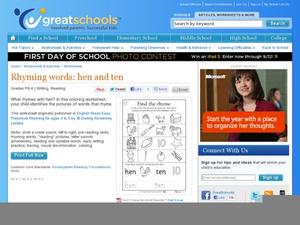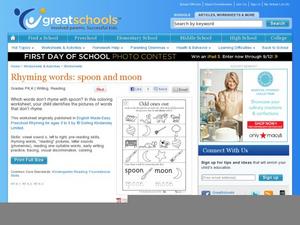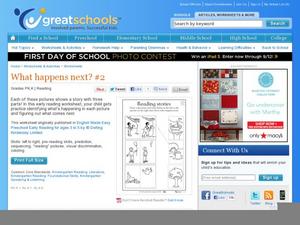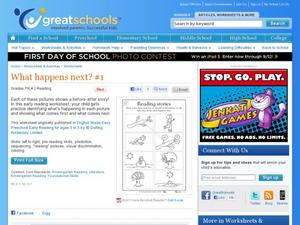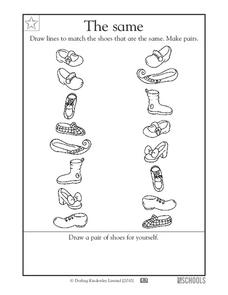Curated OER
Rhyming Words: Ball and Wall
Preschoolers and kindergartners can identify the pictures that do not rhyme with the lead image. They say each of the four words and then find the image that doesn't belong. In addition, they trace the words ball and wall.
Curated OER
Odd Ones Out
Some of these words don't rhyme; scholars determine which ones as they examine four sets of images with the vowel sound /e/. For each set, they circle the words that don't rhyme with the first image. Be sure kids know what these images...
Curated OER
Find the Rhyme
Which one rhymes? There are four starting objects here, each heading a row of three objects. Learners identify the objects and their vowel sounds to determine which one rhymes with the first object. All these rhyming words involve the...
Curated OER
Find the Rhyme
Find the rhyming word. All of these rhyming, single-syllable words have the short i sound, but learners have to determine which ones they are. There are four starting objects each heading a row of three objects. They examine the three,...
Curated OER
Rhyming Words: Fox and Socks
What rhymes with the word fox? Actually there are quite a few words that contain the short o vowel sound and rhyme with fox. Pre-readers find, color, and circle the objects in the picture that rhyme with the sly looking fox. They also...
Curated OER
Find the Rhyme
Which of these objects rhymes? There are four starter pictures here, each heading rows of three objects. Learners determine and circle the row object that rhymes with the first one. Then, they connect two of the CVC words with printing...
Curated OER
Rhyming Words: Hen and Ten
It's rhyme time! Little ones look at the image in each of four rows, they then circle an image that rhymes. They match four rhyming words and trace the words hen and ten.
Curated OER
Rhyming Words: Spoon and Moon
One of these things is not like the other, one of these things does not belong. It's true! Little learners will say each of the four words in each of four rows, to determine which one does not rhyme with the others. After that, they...
Curated OER
Odd One Out
Which word doesn't rhyme? As they practice vowel-sound recognition, scholars examine rows of familiar objects to determine which object doesn't rhyme. There are four rows here, each with a beginning image and three subsequent images....
Curated OER
What Happens Next: 2
What happens next? That is a great question that requires learners to think about the sequence of events then make a prediction. They assess the pictures on the left and draw lines to the pictures on the right that show what will happen...
Curated OER
What Happens Next? 1
Knowing how to sequence events means you have to know what happens before and after. Little ones draw a line from four before images to the images that show what happened next. This is a good challenge for your youngest learners.
Curated OER
Odd One Out
Which of these wacky shapes is different? Learners examine five rows of figures, each with a starting shape at the beginning. They determine which of the four following shapes looks different from the first, circling it. Consider having...
Curated OER
Congruent Shapes
Which of these shapes is congruent? Young geometers examine five familiar shapes: triangle, oval, rectangle, triangle, and circle. Each is followed by a set of shapes, of which one is congruent. They circle the congruent shape. Consider...
Curated OER
The Same
Which shoes match? This is surely an activity your preschoolers do daily, so use it in an educational way. They match shoes to make pairs, connecting the matches with a line. There are eight pairs in all. Next, youngsters get to draw a...
Curated OER
Real-Life Problems
There's a party going on! Learners examine an image of a birthday party and answer 10 analysis questions. They employ a variety of math skills including telling time, days of the week, division, subtraction, multiplication, addition,...
Curated OER
Same Shape and Size
Can your kindergartners recognize shapes? What about when they are in different orientations? Youngsters study groups of shapes to determine which have the same shape and size. Two of the groups have triangles and ovals, and the other...
Curated OER
Which One's Different?
One of these things is not like the others! Preschoolers identify which sock and glove is different from the rest, and draw a ring around the outlier. Then, they draw a sock and glove that are different from given pictures. Color the...
Curated OER
Drugs and Safety Precautions
Drugs can both help and harm depending on how they are used. Fifth graders complete a worksheet that provides background information on prescription drugs. They read the text and then describe why medication manufacturers label pill...
Curated OER
Fly Detective
Learners use classification skills and clues to determine which flying insect is the one they need to circle. They read four clues and examine each of the five insects depicted. They then deduce which one is the mystery insect. Answers...
John Talavera
Autism iHelp – Language Concepts
A parent of a child with autism, and a speech-language pathologist together developed this language-intervention app to be used with students with severe to moderate autism.
Curated OER
Historical Locations of The Civil Rights Movement
A geographic perspective helps historians learn about significant eras such as the civil rights movement. Through research and source analysis, learners create a report depicting a significant location of this time. They synthesize their...
Curated OER
Match the Butterflies
In this visual discrimination worksheet, students examine the pictures of butterflies and match the 5 pairs that are exactly the same.
Curated OER
Visual Literacy
Students focus on visual literacy in this instructional activity which can be incorporated to any previous instructional activity. Using images, they identify the visual elements and design in them and examining the various patterns...
Curated OER
Vocabulary
Fourth graders classify vocabulary words by category. Through matching and classification activities, 4th graders sort words pertaining to trees and forest habitats into appropriate categories. They discuss how vocabulary practice can...
Other popular searches
- B D Visual Discrimination
- Visual Discrimination Math
- Letter Visual Discrimination
- Visual Discrimination Dfnatm
- Visual Discrimination Witch
- Visual Discrimination Defiant








